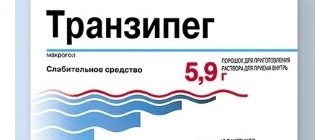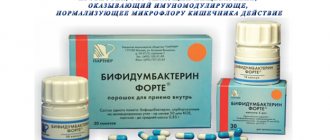Description of the drug
The main substance of the drug Fortrans is macrogol 4000. It is this that provides the laxative effect.
The powder contains:
- Sodium chloride.
- Sodium saccharinate.
- Sodium bicarbonate.
- Potassium chloride.
- Sodium sulfate anhydrous.
The auxiliary components included in the laxative are necessary to maintain normal salt and alkaline balance in the body, and are also responsible for the sweetish taste of the drug. If you take a product called Macrogol 4000 separately, this can lead to dehydration. However, the use of Fortrans is also possible only with the permission of a doctor.
The drug is produced in powder form. It is necessary to prepare a solution from it, which is taken orally. The powder is white in color and easily dissolves in water. It is packaged in paper bags. There are 4 of them in each package.
Recommendation:
“Fortrans has a specific taste that many people find unpleasant. Even passionflower extract, which is part of the powder, is not able to radically change it. In order not to provoke vomiting, you need to take the medicine with juice squeezed from citrus fruits (orange, grapefruit or lemon).”
Mechanism of action of fortrans
The powder dissolves quickly in water and does not cause electrolyte imbalance, so taking it does not lead to dehydration of the body. The drug acts in the small and large intestines and does not have a toxic effect on the body.
Fortrans has a laxative effect, increasing osmotic pressure in the intestines and retaining water in it. This promotes the dissolution of food masses, swelling of the intestinal contents and increased peristalsis. As a result, emptying occurs.
A distinctive feature of the drug is that it cleanses not only the large but also the small intestine of a person. In this case, excess fluid is not removed from the body and dehydration does not develop. Fortrans does not penetrate the systemic bloodstream, is not absorbed in the intestines, and is excreted unchanged from the body.
The effect occurs 1-1.5 hours after administration. It lasts for 2-5 hours.
If after 3 hours there is no bowel movement, then you need to massage your stomach or increase physical activity.
Fortrans should not be taken frequently; it is used for one-time bowel cleansing and is not prescribed for the treatment of constipation.
Acts of defecation occur several times, which can be achieved by taking the drug in portions. Cleaning is gentle and safe for the body. As a rule, the restoration of normal bowel movements, after stopping the use of Fortrans, occurs in the patient quite quickly.
Instructions for use
The peculiarity of taking Fortrans is that it can only be used orally, that is, drunk. Thanks to this, the most complete cleansing of the gastrointestinal tract is achieved.
When using enemas or laxative tablets, this is very difficult to achieve, since the former act exclusively in the lower intestine, and the latter in the middle section.
The remaining parts of the digestive tract may remain filled with chyme, which makes it impossible to carry out some diagnostic or therapeutic procedures.
Indications for use
A direct indication for use is the need to flush the intestines and completely free it from the masses in it for certain diagnostic or therapeutic procedures:
- X-ray of the intestines (irrigography);
- colonoscopy;
- irrigoscopy;
- surgical intervention on the intestines and neighboring organs, in which manipulation is possible only when the intestines have been emptied.
In addition, Fortrans is used to relieve the intestines of too hard stool in adult patients (over 15 years old) suffering from chronic constipation.
Mode of application
Manufacturers recommend taking Fortrans after meals with an interval of at least 2 hours between meals. To do this, it is recommended to calculate in advance the amount of solution that will be required for complete emptying.
According to the official instructions, 1 sachet of medicine is diluted in one liter of water (boiled and cooled in advance).
The solution should be prepared no more than 10-12 hours before use, and it is better to make each portion of the product immediately before taking it. The dosage of the product (the amount of prepared solution per dose) depends on the patient’s body weight.
According to the laxative manufacturer’s information, it should be calculated based on the scheme of 1 sachet per 15 or 20 kg of body weight. If, when calculating the number of sachets required to produce a laxative effect, it turns out to be fractional, rounding occurs up.
It is recommended to prepare the solution in full , without first dissolving it in a small amount of water. So, if according to calculations it is necessary to drink 3 liters of Fortrans solution, the product is diluted in the appropriate amount of water.
You need to drink the drug in small portions, half or a full glass, with an interval of 10-15 minutes. On average, it should take about 2-3 hours to consume the entire cooked portion. In most cases, stool occurs within 1 hour. Doctors recommend doing the following: drinking a new portion of the product after each visit to the toilet.
If there is no need to quickly empty the intestines (for chronic constipation, for example), the prepared solution can be taken in two approaches: drink half the volume in the evening, and the rest in the morning. In this case, the stool will be normal throughout the day.
Due to the presence of a specific taste, it is recommended to drink the product with a small amount of any sour juice - pomegranate or lemon. It will be enough to take a tablespoon of juice to avoid the gag reflex.
Release form and composition
The drug Fortrans is produced exclusively in the form of a fine powder for preparing a solution.
This product contains the main active synthetic compound - macrogol, which has the property of increasing the osmotic pressure in the intestinal lumen, thereby stimulating the formation of stool.
Additional components of Fortrans are:
- potassium and sodium chloride salts;
- sodium bicarbonate and anhydrous sulfate;
- sodium saccharinate (sweetener).
The color of the powder is white, the taste is sweet, there is no aroma. The product dissolves quickly in water without forming lumps.
Drug interactions
The active substance of Fortrans (macrogol) is absolutely inert, and therefore does not interact with other chemical compounds present in the stomach at the time of taking the solution. Moreover, the laxative is not absorbed in the stomach and intestines, and does not enter the systemic circulation. Thanks to this property of Fortrans, the drug does not interact with other drugs.
Indications and contraindications
The drug can be prescribed for the following indications:
- Planned endoscopy and fluoroscopy of the digestive system or upcoming colonoscopy.
- Upcoming intestinal surgery.
- Upcoming anoscopy, fibrocolonoscopy, sigmoidoscopy, irrigoscopy, enteroscopy.
- Sometimes the drug is prescribed before ultrasonography.
In some cases, people take Fortrans on their own to cleanse the intestines before fasting or dieting.
Contraindications to taking Fortrans:
- Hypersensitivity of the body to sulfate, bicarbonate and sodium chloride, as well as to polyethylene glycol.
- Various lesions of the intestinal walls.
- Dehydration of the body.
- Heart dysfunction.
- Stomach ulcer with perforation.
- Abdominal pain of unknown etiology.
- Gastroparesis and other disorders of the stomach muscles.
- Intestinal obstruction or suspicion of it.
- Intoxication of the body with inflammation of the digestive system.
You should also pay attention to the following recommendations:
- The drug is not prescribed to children under 15 years of age.
- Fortrans must be taken 2 hours before or 2 hours after taking other medications.
- People with serious illnesses, as well as elderly patients, should be under medical supervision while taking Fortrans.
- The drug does not cause an imbalance of electrolytes in the body, but may aggravate the course of other metabolic disorders, such as hypoglycemia.
- Fortrans should be used with caution in patients with heart and kidney failure.
- You cannot combine Fortrans with diuretics.
- Patients with aspiration and diseases of the nervous system should take the drug only in a hospital setting. The same applies to bedridden patients.
- If a person is advised to limit their salt intake, they should take into account that each sachet of the drug contains 2 g of sodium chloride.
So what and who should you choose, Moviprep or Fortrans?
Active ingredients
The composition shows that in both cases the high molecular weight substance Macrogol is used. In Fortrans it is Macrogol 4000, and in Moviprep it is Macrogol 3350. Where did the dog rummage? The answer is very simple and obvious. Preparation for colonoscopy is a long procedure, up to 16 hours with 2-stage preparation in the evening and morning, albeit with a break, and volume use of the drug up to 4 liters of solution. Macrogol 4000 is a first-generation substance; with prolonged and extensive use, a fairly large proportion of patients experience irritation and damage to the mucosa in the form of pinpoint areas of redness and hemorrhage in the rectum and sigmoid colon.
Macrogol 3350 is a second-generation drug with a reduced molecular weight, so doctors observe much less irritation and damage to the mucous membrane when using it.
Taste properties
But both Fortrans and Moviprep contain sodium sulfate, which is responsible for the laxative effect and gives the drugs bitterness. In the case of Fortrans, the taste qualities were not resolved in any way for “comfortable” use by patients: we see in the composition soda (sodium bicarbonate) and a sweetener (sodium saccharinate). As a result, the drug is difficult to tolerate for many in terms of taste - bitter and cloying. Hence the shudders and goosebumps in patients when he is mentioned. It was experimentally found that adding 100 ml of freshly squeezed lemon juice to 900 ml of the finished solution (obtained from one Fortrans package) significantly improves the taste properties of Fortrans.
The manufacturers of Moviprep took this feature into account. The package includes two small packets - sachets, which contain ascorbic acid, sodium ascorbate and lemon flavor, which, when dissolved in water, imitate the addition of lemon, and the drug initially becomes more pleasant to use.
Scope of application
To this we must add that when preparing with Fortrans, the patient has to drink a total amount of liquid of 4 liters with the taste of the drug. And when preparing with Moviprep, you only need to drink 2 liters of the drug with improved taste. The remaining 2 liters can be brought up to 4 liters with any clear liquid. For example, chicken broth, tea without milk, juice without pulp, plain water. Alcoholic and carbonated drinks are not allowed.
Side effects
The side effects of the drugs are approximately the same - very often nausea, vomiting, flatulence, and cramping abdominal pain occur. In addition, Moviprep often has sleep disturbances, dizziness, and headaches.
The use of both drugs in elderly and debilitated patients must be under medical supervision. Also, both drugs are used only from 18 years of age. During pregnancy and lactation, both drugs are prescribed according to strict indications and their use is limited.
No effect on the control of machinery and vehicles has been identified when using Moviprep, but caution is recommended when using Fortrans, especially if sedation with propofol is used.
Admission restrictions
Of the special instructions, it is necessary to take into account that Moviprep contains aspartame, therefore it is contraindicated in case of phenylketonuria, and ascorbate, which is harmful in case of glucose-6-phosphate dehydrogenase deficiency.
The use of Fortrans is limited in case of renal failure, inflammation of the intestinal mucosa, including the rectum, and is contraindicated in cases of gastric and duodenal ulcers (bleeding is possible).
How to take Fortrans correctly?
Each package of the medicine contains detailed instructions for use and 4 sachets of powder. One such sachet should be dissolved in a liter of water.
Rules of application:
- The solution should be taken 12 hours before the upcoming operation or examination.
- Take it for 3-6 hours.
- Drink the solution in small sips.
If you take the drug at night, you will not be able to achieve high-quality intestinal cleansing.
One liter of the drug is designed for 20 kg of weight, so if a person weighs 70-85 kg, 4 sachets will be enough for him. When the patient's weight is 60 kg, he needs to take 3 sachets. If you weigh 100 kg or more, you will need 5 sachets of the drug.
It is prohibited to exceed the recommended dose, as this will provoke poisoning with the development of side effects.
If an examination or operation is planned in the morning, then the drug should be taken as follows:
- You need to have breakfast as usual.
- Lunch should take place no later than 2-3 pm.
- The rest of the time is allocated to cleansing the intestines with taking Fortrans.
From the moment you start cleaning until the procedure, you must refuse food. Drink the solution every 2 hours after the last meal.
It is not recommended to use Fortrans to remove toxins from the intestines more than 2-3 times a year. It can cause dysbiosis with the proliferation of pathogenic flora in the intestines. This increases the likelihood of developing colitis, enteritis and chronic constipation. In addition, frequent use of laxatives can lead to the leaching of vitamins and microelements from the body.
Advantages and disadvantages
Advantages of using the drug Fortrans:
- With its help, it is possible to cleanse not only the large intestine, but also the small intestine.
- The drug can be used at home.
- The dose is easy to calculate, just know your body weight. For every 20 kg of weight you need to drink a liter of solution. To prepare this volume you need 1 sachet of medicine.
- The drug is easy to take. It is drunk in the evening for 4-5 hours.
- Four sachets are enough to perform a complete cleaning.
As for the disadvantages of the drug, these include the unpleasant taste of the finished solution and the need to take large volumes of liquid.
Side effects that may develop after taking Fortrans:
- Nausea and vomiting. After completing the course, these phenomena go away on their own.
- Bloating.
- Allergic reactions: skin rash, swelling. Isolated cases of anaphylactic shock have also been reported.
Side effects
When taking the laxative Fortrans, undesirable reactions may occur from some internal organs and their systems.
The most common side effects patients notice are:
- heaviness and feeling of fullness in the intestines and/or stomach;
- nausea (occurs mainly due to aversion to the taste of the solution);
- increased gas formation;
- allergic reactions in the form of rash, swelling and/or itching.
Undesirable reactions go away on their own a day or two after you stop taking the laxative. No specific treatment is required.
Contraindications
Fortrans does not have a list of diseases and conditions for which the drug must be taken with caution. At the same time, the list of strict (absolute) contraindications is quite extensive. It includes:
- complete or partial intestinal obstruction or a high risk of its occurrence;
- dehydration;
- expansion of the colon of toxic etiology;
- perforation of any part of the digestive tract;
- malignant tumors of the intestines and stomach;
- pathological narrowing of the intestine;
- erosions and ulcers on the mucous membrane of the digestive tract;
- intolerance to any component of the laxative.
In the presence of the listed diagnoses, the drug Fortrans is not prescribed.
Use during pregnancy and lactation
There is no information on the use of the Fortrans laxative during pregnancy, so it is recommended to use it only in cases of urgent need or if there are absolute indications for its use.
When breastfeeding, the drug is allowed for use, since it does not enter the systemic bloodstream and directly into breast milk, and therefore cannot enter the child’s body.
How to eat after a colon cleanse?
After deep cleansing of the intestines, it will need to be restored. The drug flushes out not only toxins, but also beneficial substances from the body.
Products such as Linex and Bifidumbacterin help restore microflora.
The next morning after cleansing, you need to eat boiled rice without salt and spices. It can be eaten throughout the day. It is necessary to avoid carbonated drinks and rough foods.
Be sure to drink as much water as possible. Portions should be small and you should not overeat.
Analogs
Fortrans has many advantages, but it is quite expensive (500 rubles per pack), so many patients are interested in the availability of analogues of this drug. Moreover, it has an unpleasant taste and should not be used by children.
Macrogol is contained in such drugs as:
- Osmogol.
- Lavacol. This is a domestic drug. The package contains 15 sachets. The cost of the medicine is 180-230 rubles. According to reviews, Lavacol tastes much better than Fortrans. However, doctors indicate that Fortrans cleanses the intestines better than Lavacol.
- Forlax. For 20 bags of 10 g you will need to pay 310-340 rubles. Forlax, as well as Fortrans, are produced in France.
- Transipeg.
- Forteza Rompharm.
- Relaxan.
- Endofalk contains macrogol 3350. This drug works in the same way as Fortrans. Its cost is 480 rubles.
- Fleet Phospho-Soda. This drug is based on a substance called sodium hydrogen phosphate dodecahydrate. However, the drug works the same way as Fortrans. The taste of Fleet Phospho-Soda is not very pleasant, but this does not affect the effectiveness of the drug. Its cost is 560 rubles.
These drugs have the same indications and contraindications.
If a person has an individual intolerance to macrogol, then you can use drugs such as:
- Duphalac. Available in the form of syrup (15 ml) the package contains 10 sachets. The drug is produced in Germany and costs 310-335 rubles.
- Bioflorax.
- Lactuvit.
Analogues also include Goodluck medicines in syrup, magnesium sulfate powder (a 25 g bag costs 40-60 rubles), Normaze syrup, Transulose gel, suppositories and Bisacodyl tablets. All these drugs can be used in childhood as an alternative to enemas.
Difficulty of choice
Due to different preparations, it is often necessary to answer patients’ questions, “which drug to choose for better preparation,” “Moviprep or Fortrans, which is better?”
I’ll make a reservation right away. There are drugs that patients prefer, and there are drugs that doctors prefer. It happens that a good drug works for one person, but does not work for another. But the drug, which is modest in properties, resonates with the latter.
People are all personalities and individuals. Doctors do not treat diseases, but people, who are all different, with different sets of characteristics and diseases. Therefore, the drug for bowel cleansing before colonoscopy sometimes has to be selected individually.









